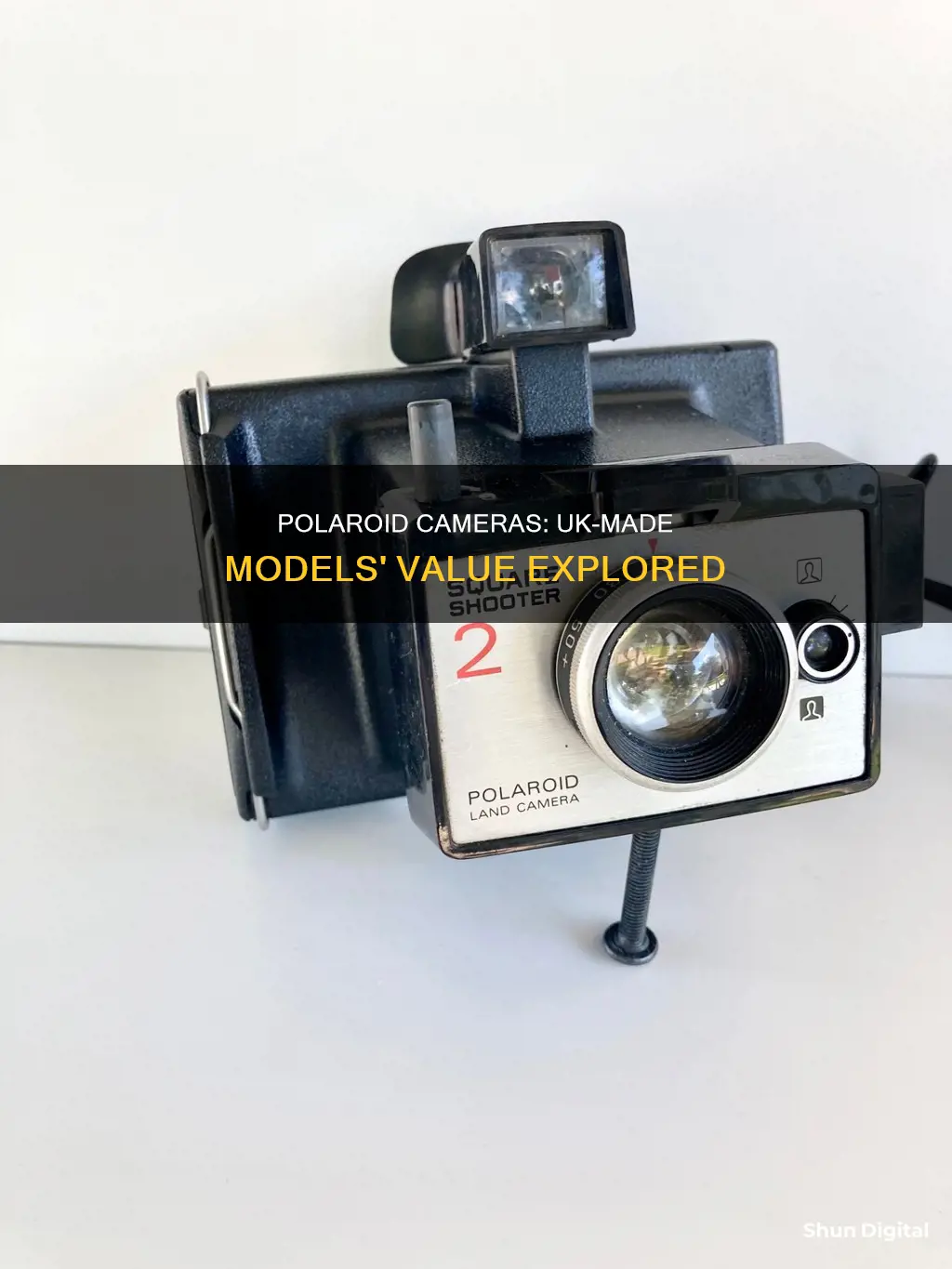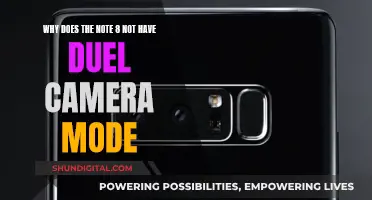
Polaroid cameras have been around for more than 70 years, with the first camera released in 1948. The company manufactured cameras in the UK, specifically in Dumbarton and the Vale of Leven, Scotland. The serial numbers on 600 models were updated to reflect the country of manufacture, with the letter V indicating the UK.
Vintage Polaroid cameras can vary in value depending on several factors, including model, rarity, historical significance, and demand. In general, they can range from as little as $10 to over $1000.
Some of the most valuable Polaroid models include the SX-70 Land Camera, the Polaroid OneStep Sonar Gold, the Polaroid 690, and the Model 100 Land Camera. These cameras can sell for hundreds or even thousands of dollars, depending on their condition and rarity.
The country of origin can also impact the value of a Polaroid camera, with some collectors seeking out specific models made in certain countries.
What You'll Learn

Polaroid's UK manufacturing history
Polaroid cameras have been manufactured in the UK for decades. The company's history in the country is a story of innovation, success, and eventual decline in the face of digital technology. Here is a detailed look at Polaroid's UK manufacturing history:
The Early Years
Polaroid Corporation was founded in 1937 by Edwin H. Land, a young scientist with a passion for photography. The company's first instant camera, the Model 95, was introduced in 1947 and hit the markets in 1948. This camera revolutionised the photography industry, allowing users to produce a finished print in just 60 seconds.
Expansion and Innovation
Throughout the 1950s and 1960s, Polaroid continued to innovate, releasing new cameras and films that were smaller, lighter, and more convenient. In 1963, they introduced the iconic Polaroid Swinger camera, which became an instant hit and helped popularise instant photography among a wider audience. During this period, Polaroid also established its presence in the UK, with subsidiaries in Frankfurt and Toronto, and a Japanese firm licensed to produce cameras for overseas sale.
The Golden Age
The 1970s and 1980s were a golden age for Polaroid, with the company introducing groundbreaking products like the SX-70 in 1972, the first integrated camera and film system. Despite financial troubles and a costly patent-infringement battle with Kodak in the late 1970s, Polaroid continued to be a leader in instant photography.
Decline and Revival
In the 1990s, Polaroid faced increasing competition from digital photography. The company attempted to transition to digital technology but struggled to keep up with the rapidly evolving market. In 2001, Polaroid filed for bankruptcy and stopped producing instant film. However, the company's legacy lived on. In 2008, former Polaroid employees formed The Impossible Project, which acquired the rights to produce instant film for vintage Polaroid cameras.
UK Manufacturing
During the late 1980s and early 1990s, Polaroid expanded its UK camera operation, making the country the primary manufacturer of 600 and Spectra cameras for the European and North American markets. The serial numbers on 600 models made in the UK were updated to include the letter "V", likely chosen to represent Vale of Leven, the location of their UK camera operation and film manufacturing.
Final Years and Legacy
As digital photography took over, Polaroid's production shifted to China in the mid-to-late 1990s. In 2008, Polaroid shuttered, but the brand was revived in 2017 when the CEO of The Impossible Project bought the Polaroid brand and intellectual property. Today, Polaroid cameras and film are back, with new models offering a blend of instant prints and digital features.
In summary, Polaroid's UK manufacturing history spans several decades, from the company's early innovations in instant photography to its eventual decline and revival. The UK played a crucial role in producing iconic cameras that shaped the world of photography, with Vale of Leven serving as a key manufacturing hub.
Polaroid Camera Battery Guide: Which Batteries to Use?
You may want to see also

The value of antique cameras
Antique cameras can be valuable for a variety of reasons. The older a camera is, the more likely it is to be worth a higher price. This is especially true if the camera is a rare model or was particularly good when it was first released. Cameras made of metal are often worth more than those made of plastic, as metal cameras tend to be sturdier and have a wider range of shutter speeds.
The brand of a camera can also impact its value. Leica and Rolleiflex cameras, for example, have long been considered collector's items. Polaroid cameras have also surged in popularity in recent years, with some vintage models selling for over $1,000. Special edition Polaroid cameras, such as those themed after McDonald's, Mickey Mouse, or the Grand Canyon, are often among the best-value Polaroid cameras to sell.
The condition of the camera is another important factor in determining its value. A camera that is in good working condition will typically be worth more than one that is broken or damaged. Additionally, having the original documents, packaging, manuals, cases, straps, boxes, lens covers, and other accessories can also increase a camera's value.
It is worth noting that the value of antique cameras can vary widely, and it is difficult to place an exact value on a camera without a full physical assessment. The best way to get a rough estimate of a camera's value is to research similar cameras that have been sold online or through auction houses.
Vivint Camera Privacy Mode: How Does It Work?
You may want to see also

Polaroid's history and downfall
The Polaroid Corporation was an American company founded in 1937 by Edwin H. Land, a scientist and researcher, to commercialise his Polaroid polarizing polymer. The company's initial market was polarised sunglasses, but it soon expanded into other products, including 3D movie technology and protective goggles for military dogs.
In 1948, the first instant Polaroid camera was created by Land. This camera, the Model 95 Land Camera, still relied on the photographer to time the development of the film and use a pod of film-developing chemicals. The prints were sepia-toned, but in 1950, black-and-white film was introduced, followed by colour film in 1963. By 1972, the film had been further improved to eliminate the need for peeling off a top layer, and prints developed faster than ever, often in under a minute.
During the 1970s, Polaroid cameras quickly grew in popularity, and the company reached its peak revenue of $3 billion in 1991. However, the 1980s saw the advent of new technologies that would profoundly change the world of photography, including one-hour colour film processing, single-use cameras, videotape camcorders, and, in the 1990s, digital cameras.
Polaroid struggled to keep up with these innovations, and its downfall was largely attributed to the failure of senior management to anticipate the impact of digital cameras on its film business. In 2001, the original Polaroid Corporation was declared bankrupt, and its brand and assets were sold off. The company ceased making Polaroid cameras in 2007 and discontinued the sale of Polaroid film after 2009.
However, Polaroid cameras have enjoyed a revival in recent years, with new generations of the camera trending among young people and photo enthusiasts. This renaissance is partly due to nostalgia and a growing boredom with digital photography, as well as the unique appeal of having a physical photograph. Today, Polaroid-branded products are developed and released by various licensees globally, and the brand has expanded into other fields, such as LCD televisions and DVD players.
Quickly Copy Edits in Camera Raw Like a Pro
You may want to see also

The Impossible Project
In the early 2000s, Polaroid was relaunched as a digital brand and film sales were phased out. This was unsuccessful, and in 2008, Polaroid filed for bankruptcy again. This time, they were getting rid of their film production factories, and a handful of Dutch entrepreneurs and Polaroid experts took over the lease as The Impossible Project.
Although the machinery was there, the patents and other IP for the Polaroid instant film were not. So, The Impossible Project had to reinvent the process from scratch. They persevered, aided by a passionate community of Polaroid owners and film enthusiasts. In time, the process matured, and Impossible developed new films and distribution partners.
In 2017, the student became the master as Impossible’s CEO purchased the Polaroid brand name and IP. They relaunched Impossible as “Polaroid Originals” and released the OneStep 2 camera using a new “i-Type” film process that more closely resembled old Polaroids.
The merger was now complete, and Polaroid, Polaroid Originals, and The Impossible Project were finally one and the same. All devices and films would be released under the Polaroid name, though there may be new sub-brands. The first camera released under the merged brand was the Polaroid Now.
Charging Your Panasonic Lumix DMC-FZ70 Camera Battery: A Guide
You may want to see also

Polaroid's modern-day products
Polaroid has undergone a series of changes since its bankruptcy in 2001. The brand has changed hands multiple times, and the company has expanded its product line to include modern digital photography and consumer electronics. Here is an overview of Polaroid's modern-day products and their evolution:
Instant Cameras:
Polaroid is best known for its instant cameras, and the company has continued to innovate in this space. The modern Polaroid instant cameras have evolved to include digital features. For example, today's models often allow users to capture digital images alongside instant prints, offering higher resolution and better colour accuracy. These modern instant cameras also come with creative features such as multiple exposure modes, self-timers, built-in filters, and various shooting modes.
Digital Cameras:
Polaroid was one of the early manufacturers of digital cameras, releasing the PDC-2000 in 1996. However, they failed to capture a significant market share in that segment. After their bankruptcy, Polaroid licensed the brand for digital cameras, and various models have been released since then. In 2012, Polaroid even ventured into "smart cameras" with the Polaroid SC1630, which combined a camera with a portable media player running on Google Android.
Action Cameras:
In 2014, Polaroid introduced the "Polaroid Cube", an action camera priced at $99 as a casual alternative to more expensive options like the GoPro Hero.
Mobile Printers:
Polaroid has also released instant mobile printers, such as the Polaroid GL10 Instant Mobile Printer, which allow users to print photos directly from their mobile phones or digital cameras.
Consumer Electronics:
Since the original Polaroid Corporation's downfall, the Polaroid brand has been used for various consumer electronics products developed and released by global licensees. This includes LCD televisions, DVD players, and portable DVD players.
Film:
Polaroid film has also seen a revival. After Polaroid ceased production of instant film in 2008, The Impossible Project was founded to continue producing instant film for older Polaroid cameras. In 2017, The Impossible Project acquired Polaroid and rebranded as Polaroid Originals, and eventually as Polaroid in 2020. The new Polaroid-branded instant film has been met with mixed reviews, with some users noting that it is not as good as the original formula.
Sharpening RAW Files: In-Camera vs Post-Processing
You may want to see also
Frequently asked questions
UK-made Polaroid cameras may be more valuable due to their country of origin, but there are many other factors that determine a camera's value, such as age, rarity, condition, and features.
The value of a Polaroid camera is influenced by its age, rarity, condition, working order, cosmetic condition, features, accessories, demand, and historical significance.
The value of a vintage Polaroid camera can range from as little as $10 to over $1,000, depending on various factors. Some rare models can even sell for several thousand dollars.
Some valuable Polaroid camera models include the SX-70 Land Camera, the Polaroid OneStep Sonar Gold, the Polaroid 180 and 195 Land Cameras, the Polaroid 690 and 690 SLR, and the Model 100 Land Camera.
You can sell your Polaroid camera on online marketplaces such as eBay or Amazon, or through specialist sites such as Retrospekt, or online auctions for more valuable models. Researching similar models, identifying the specific year and features of your camera, and consulting experts and appraisers can help you determine the best selling option.







